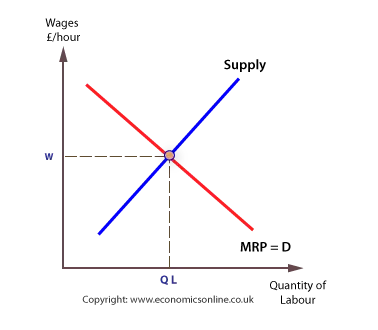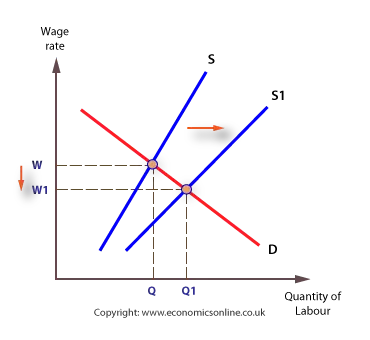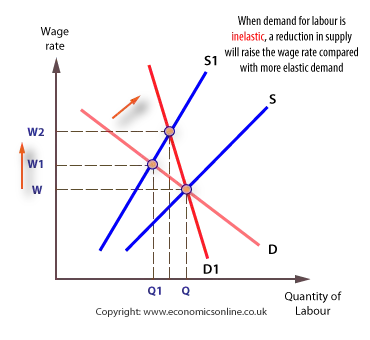
Wages and employment
Wages and employment
Characteristics of a perfectly competitive labour market
A perfectly competitive labour market has a number of key characteristics including:
- No barriers to entry for labour.
- Perfect knowledge of available jobs.
- Each unit of labour is identical to every other unit.
- The labour supply curve is perfectly elastic.
- Firms can hire all they need, depending on their demand.
This means that the equilibrium wage rate and employment will be determined by the intersection of the horizontal labour supply curve, and the downward sloping MRP (D) curve.
The wage rate is determined by the whole market, and this sets the wage rate for all firms in the market. They will demand the labour they need, depending on the marginal revenue product of labour.
The firm itself determines the quantity of labour demanded. If the demand for labour by an individual firms changes the quantity of workers employed. In the diagram, the shift in demand for labour (to the left) reduces the level of employment for the single firm.
The competitive market wage rate, and the quantity of labour employed, is determined by the interaction of demand and supply. The equilibrium wage rate is the rate that equates demand and supply, as illustrated below.
Equilibrium wage rate

Labour supply for the whole market is assumed to be positively related to the wage rate, and the market supply curve slopes upwards.
Changes in market wage
Market wage may change following a change in an underlying condition of demand or supply.
Shifts in the demand for labour
Demand can change, and the demand curve will shift, under a number of circumstances, including changes in:
- The productivity of labour.
- The price of the product.
- Demand for the product.

Shifts in the supply curve
Labour supply can change under a number of circumstances, including changes in:
- The length of the working week.
- Participation rates.
- Demographic factors, such as migration, and changes in the age structure of the population.
- Qualifications and skills required.
- The length of training.

The importance of elasticity
The effect on the wage rate and level of employment of a shift in either the demand or supply of labour depends upon the elasticity of the other curve.
For example, if the demand for labour is very inelastic, perhaps because there are no substitutes for labour, the effect of a strike is to raise the wage rate, but leave employment largely unaffected. The result is that workers will gain as a group, even though some individual workers will lose their jobs.

Go to wage differentials
Go to economic rent and transfer earnings


